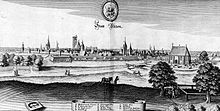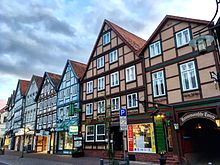Uelzen
Uelzen
Ülz'n (Low German) | |
|---|---|
 | |
Location of Uelzen within Uelzen district  | |
| Coordinates: 52°57′53″N 10°33′57″E / 52.96472°N 10.56583°E | |
| Country | Germany |
| State | Lower Saxony |
| District | Uelzen |
| Subdivisions | 16 districts |
| Government | |
| • Mayor (2021–26) | Jürgen Markwardt[1] (SPD) |
| Area | |
• Total | 135.84 km2 (52.45 sq mi) |
| Elevation | 43 m (141 ft) |
| Population (2022-12-31)[2] | |
• Total | 33,934 |
| • Density | 250/km2 (650/sq mi) |
| Time zone | UTC+01:00 (CET) |
| • Summer (DST) | UTC+02:00 (CEST) |
| Postal codes | 29525 |
| Dialling codes | 0581 |
| Vehicle registration | UE |
| Website | www.uelzen.de |
Uelzen (German: [ˈʏltsn̩] ; Template:Lang-nds[3]), officially the Hanseatic Town of Uelzen (Template:Lang-de), is a town in northeast Lower Saxony, Germany, and capital of the district of Uelzen. It is part of the Hamburg Metropolitan Region, a Hanseatic town and an independent municipality.
Uelzen is characterised by timber-framed architecture and also has some striking examples of North German brick Gothic. The town earned pan-regional fame when Friedensreich Hundertwasser was selected to redesign the railway station: the final work of the celebrated Viennese artist and architect was ceremonially opened in 2000 as the Hundertwasser Station, Uelzen, and remains a popular tourism destination.
The Polabian name for Uelzen is Wilcaus (spelled Wiltzaus in older German reference material), possibly derived from wilca or wilsa (< Slavic *olăša) 'alder'.
Geography
Location
Uelzen lies on the eastern edge of the Lüneburg Heath. The town is a transport hub on the north–south axis from Hamburg to Hanover as well as the east–west axis from Bremen to Berlin. Also of economic importance is its location on the Elbe Lateral Canal. The town is situated on the Ilmenau, and the banks in Uelzen are dotted with small parks wetland areas. Large areas in the vicinity of Uelzen have been set aside as nature parks with moors, woods, lakes, and heathland: the Elbhöhen-Wendland Nature Park, Lüneburg Heath Nature Park and Lower Saxon Elbe Valley Water Meadows Biosphere Reserve.
Divisions
The following parishes belong to the borough of Uelzen: Groß Liedern, Halligdorf, Hambrock, Hansen, Hanstedt II, Holdenstedt, Kirchweyhe, Klein Süstedt, Masendorf, Mehre, Molzen, Oldenstadt, Riestedt, Ripdorf, Tatern, Veerßen, Westerweyhe, and Woltersburg.
Furthermore, there are four other places that have the status of "special parishes" (Sonstige Ortsteile): Borne, Kl. Liedern, Pieperhöfen, and Oldenstadt-West.
History


The town was founded in 1250. In 1270 Duke John of Brunswick-Lüneburg, a Welf who ruled the Principality of Lüneburg from 1252 to 1277, granted Uelzen its town privileges (Stadtrechte).[4] In the Middle Ages it became an active member of the Hanseatic League.[5] The town fortification, built in the 14th century, originally had three gates, a wall, and a moat. Parts of the wall are still standing.
While Uelzen only played a small role in the Hanseatic League, there is evidence that it traded with Livonia and Spain.[citation needed] At the Schnellenmarket, a London trading office purchased Uelzener linen, earthenware pitchers were offered for sale and brewery business flourished.[citation needed] On 21 October 1470, Uelzen was the venue for a Hanseatic League Convention. This was a special honor, as these annual resolutions of the association of cities usually took place in Lübeck.[6]
The town became part of the Electorate of Hanover in 1708, the Kingdom of Westphalia in 1807, the Kingdom of Hanover in 1814, and the Prussian Province of Hanover in 1866.
Uelzen was the site of a Nazi concentration camp that operated in Uelzen until 17 April 1945. The camp was a subcamp of the Neuengamme concentration camp.[7]
Uelzen was hit by five air raids during World War II, on 18 April 1944, 10 November 1944, 27 November 1944, 22 February 1945 and 7 April 1945. Across these raids, 1362 buildings were destroyed or damaged.[8] The heaviest raid was on 22 February 1945 when 149 people lost their lives and 95 houses were completely destroyed. On 7 April 1944, three civilians were killed and 153 houses were destroyed or damaged. [9] Estimates indicate up to 27% of the town was destroyed at some point during the war.[citation needed]
Governance



Uelzen belongs to the Bundestag constituency of Celle-Uelzen. In 2009 Henning Otte (CDU) was directly elected, having been on the state list (place 19) since 2005. Kirsten Lühmann (SPD) was elected in 2009 via the state list. In the years 1998, 2002 and 2005 Peter Struck (SPD), former defense minister and chairman of the SPD party in the German Bundestag, was directly elected.
Mayor
Jürgen Markwardt (independent) has been the mayor of Uelzen since 2014, when he was elected with 64.4% of the vote. The deputy mayors are Karsten Jäkel (CDU) and Ariane Schmäschke (The Greens).
- 1913–1946: Johann Maria Farina.
- 1946: Dr. Heinz Lücke (CDU).
- 1946–1948: Adolf Hochgraefe (SPD).
- 1948–1950: Dr. Heinz Lücke.
- 1950–1952: Adolf Hochgraefe.
- 1952–1961: Dr. Heinz Lücke.
- 1961–1963: Adolf Hochgraefe.
- 1963–1964: Dr. Heinz Lücke.
- 1964–1972: Alfred Krüger (CDU).
- 1972–1979: Rudi Schrödter (SPD).
- 1979–1981: Hans-Alexander Drechsler (SPD).
- 1981–1991: Rudolf Froin (CDU).
- 1991–1997: Günter Leifert (SPD).
- 1997–2001: Günter Leifert (hauptamtlich).
- 2001–2014: Otto Lukat (SPD).
- 2014: Jürgen Markwardt (independent).
Twin towns – sister cities
 Barnstaple, England, United Kingdom
Barnstaple, England, United Kingdom Bois-Guillaume, France
Bois-Guillaume, France Kobryn, Belarus
Kobryn, Belarus Tikaré, Burkina Faso
Tikaré, Burkina Faso
Arts and culture

Theatre
Uelzen contains a number of theaters,including the theatre on the Ilmenau, the Jabelmann Events Hall, and the fringe theatre on the Rosenmauer.
Museums
Worthy of mention is the Holdenstedt Castle Museum which is the town's local history museum. Permanent exhibitions include furniture from the Middle Ages, a glass collection, artwork by painter Georg Wolf, and archaeological finds from the local area.
Economy

The largest sugar beet refinery in the Nordzucker group is in Uelzen. It processes approximately 20,000 tons of sugar beet per day. Other large employers in the town are Nestlé Schöller or the dairy manufacturer Uelzena. Bituminous roofing felts and insulation material has been manufactured in Uelzen by C. Hasse & Sohn since 1872.
Infrastructure
Railway station
The Hundertwasserbahnhof is a railway station in Uelzen at the eastern edge of the Lüneburg Heath Nature Park in northeastern Lower Saxony. Cities directly reachable by rail from this hub are Hamburg, Hannover, Lüneburg, Celle, Braunschweig, Bremen and Berlin.
The original station was renovated for Expo 2000 following plans by the Austrian artist and architect Friedensreich Hundertwasser. An "environmentally, culturally oriented" station, the station was renamed after the architect as 'Hundertwasser Station, Uelzen'. Today it is one of the town's popular tourist attractions.
Courts
Uelzen has a district court (Amtsgericht), which belongs to the state court region of Lüneburg and the Oberlandesgericht (High State Court) region of Celle.
Education
Schools in Uelzen include the Herzog-Ernst-Gymnasium, Lessing-Gymnasium, Oberschule-Uelzen, Lucas-Backmeister-Schule, Sternschule, Berufsbildene Schulen I and II and 6 elementary schools.
Health and medicine
Uelzen has one hospital (HELIOS Klinikum), two clinics that specialise in different areas (Klinik Veerßen and Psychiatrische Klinik Uelzen) and some pharmacies and dentists.
Notable people

- Ernest I, Duke of Brunswick-Lüneburg (1497–1546), Prince of Lüneburg, ruled the Lüneburg-Celle subdivision of the Welf family's Brunswick-Lüneburg duchy from 1520 until his death
- Francis, Duke of Brunswick-Lüneburg (1508–1549), ruled the newly founded Duchy of Gifhorn from Gifhorn Castle
- Eberhard August Wilhelm von Zimmermann (1743–1815), geographer and biologist
- Friedrich Kuhlau (1786–1832), court composer to the Danish royal court
- Georg Wilding (1790–1841), royal-Neapolitan envoy in St. Petersburg
- Theodore Kaufmann (1814–1896), American painter
- Walter Wallmann (1932–2013), politician (CDU)
- Angelika Volquartz (born 1946), politician (CDU), 2003–2009 Mayor of Kiel
- Rebecca Harms (born 1956), politician (The Greens)
- Mola Adebisi (born 1973), TV presenter (VIVA)
- André Doehring (born 1973), musicologist
- Felipe Fernández Laser (born 1988), racing driver
See also
Notes
- ^ "Direktwahlen in Niedersachsen vom 12. September 2021" (PDF). Landesamt für Statistik Niedersachsen. 13 October 2021.
- ^ "LSN-Online Regionaldatenbank, Tabelle A100001G: Fortschreibung des Bevölkerungsstandes, Stand 31. Dezember 2022" (in German). Landesamt für Statistik Niedersachsen.
- ^ Eduard Kück: Lüneburger Wörterbuch. Wortschatz der Lüneburger Heide und ihrer Randgebiete, seit 1900 zusammen mit vielen Mitarbeitern gesammelt und sprachwissenschaftlich sowie volkskundlich erläutert von Professor Dr. Eduard Kück. Dritter Band: S–Z. Neumünster: Karl Wachholtz 1967
- ^ "Uelzen - Hanse.org". Archived from the original on 2011-09-26. Retrieved 2011-06-06.
- ^ Chisholm, Hugh, ed. (1911). . Encyclopædia Britannica. Vol. 27 (11th ed.). Cambridge University Press. p. 556.
- ^ "Uelzen". www.hanse.org. Retrieved 23 April 2018.
- ^ The camp is listed as No. 1491 Uelzen in the official German list.
- ^ "Hansestadt Uelzen - aus dem Archiv: April 1945 – der Krieg geht in Uelzen zu Ende".
- ^ "Alliierte bombardierten Uelzen 1944 und 1945 wegen Eisenbahn-Knotenpunkt". 28 January 2022.
- ^ "Internationale Partner". hansestadt-uelzen.de (in German). Uelzen. Retrieved 2021-02-18.
References
- Official German list of concentration camps Verzeichnis der Konzentrationslager und ihrer Außenkommandos (in German)
- Johann Parum Schultze; Reinhold Olesch (Hrsg.): Fontes linguae Dravaenopolabicae minores et Chronica Venedica J. P. Schultzii. (= Slavistische Forschungen; Band 7). Böhlau, Köln und Graz 1967
- Christian Hennig von Jessen: Vocabularium Venedicum (oder Wendisches Wörter-Buch) (1705). Nachdruck besorgt von Reinhold Olesch. - Köln [u.a.]: Böhlau 1959 (Gewährsmann des Pastors C. Hennig von Jessen war der polabisch sprechende Bauer Johann Janieschge aus Klennow)
External links
- Official site (in German)
- Uelzen website translated to English with google translation
- . Encyclopædia Britannica (11th ed.). 1911.



